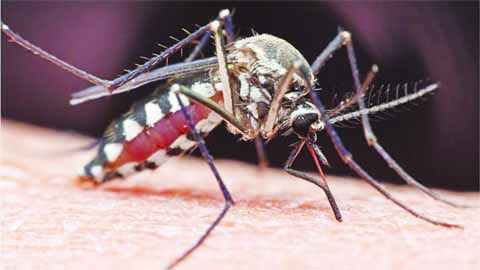
bdnews24.com :
Construction sites in Dhaka have turned into a common breeding ground for mosquitoes as city authorities scramble to prevent another calamity after a record number of people were affected in a widespread dengue outbreak last year.
A survey by the Directorate General of Health Services or DGHS found that under-construction buildings are increasingly becoming nesting sites for mosquitoes.
According to the health directorate, a lack of awareness-and even unwillingness-on the part of construction companies to address the issue is further compounding the situation.
Although the threat of the mosquito menace was relatively low during the dry winter season, it can resurface in the monsoon, warned experts.
They suggested taking necessary precautionary measures beforehand to thwart another dengue crisis.
As part of a programme to curb malaria and Aedes mosquito-borne diseases, the DGHS launched a drive in December last year to identify the breeding grounds for mosquitos within the areas of the two city corporations.
The survey was conducted in 100 neighbourhoods in 98 wards under the two city corporations and took into account a thousand households and structures in Dhaka. The DGHS has recently published a report on its findings.
The report showed that 36 percent of residences in Dhaka South and 32 percent in Dhaka South had a ‘house index’ rating of 10. Construction work was ongoing in more than 40 percent these houses.
The house index is used as an indicator of the risk of vector-borne diseases in a particular area. The situation is considered ‘hazardous’ if Aedes larvae or pupa is present in five or more houses out every hundred in an area.
Mosquitoes were more prevalent at the under-construction buildings in different neighbourhoods, DGHS Director General Abul Kalam Azad said, citing the survey. He believes the prevalence of mosquitoes can be controlled during the upcoming monsoon if the authorities focus on these sites.
“The authorities found water-filled barrels and high number of mosquitoes in these places. There won’t be any Aedes larvae if we remove the stagnant water. We can’t address this issue if we only focus on larvicide rather than eliminating the breeding grounds.”
The presence of mosquitoes at most construction sites is likely to grow in monsoon, believes Prof Kabirul Bashar of Jahangirnagar University’s Zoology Department.
The survey report substantiated his claim as it showed that 32 percent of the houses in Dhaka North had a house index score of 10 after monsoon while the percentage is 38 prior to monsoon and 60 during the rainy season.
In Dhaka South, 36 percent of residences scored 10 in the house index, down from 81 percent during and 60 percent prior to the monsoon. Construction sites can be held liable for half of the dengue cases recorded in Dhaka last year, according to Prof Kabirul. “The dengue-carrying Aedes mosquitoes breed in these construction sites. Therefore, construction companies should come forward and take responsibility to contain the menace.”
A survey by the Directorate General of Health Services or DGHS found that under-construction buildings are increasingly becoming nesting sites for mosquitoes.
According to the health directorate, a lack of awareness-and even unwillingness-on the part of construction companies to address the issue is further compounding the situation.
Although the threat of the mosquito menace was relatively low during the dry winter season, it can resurface in the monsoon, warned experts.
They suggested taking necessary precautionary measures beforehand to thwart another dengue crisis.
As part of a programme to curb malaria and Aedes mosquito-borne diseases, the DGHS launched a drive in December last year to identify the breeding grounds for mosquitos within the areas of the two city corporations.
The survey was conducted in 100 neighbourhoods in 98 wards under the two city corporations and took into account a thousand households and structures in Dhaka. The DGHS has recently published a report on its findings.
The report showed that 36 percent of residences in Dhaka South and 32 percent in Dhaka South had a ‘house index’ rating of 10. Construction work was ongoing in more than 40 percent these houses.
The house index is used as an indicator of the risk of vector-borne diseases in a particular area. The situation is considered ‘hazardous’ if Aedes larvae or pupa is present in five or more houses out every hundred in an area.
Mosquitoes were more prevalent at the under-construction buildings in different neighbourhoods, DGHS Director General Abul Kalam Azad said, citing the survey. He believes the prevalence of mosquitoes can be controlled during the upcoming monsoon if the authorities focus on these sites.
“The authorities found water-filled barrels and high number of mosquitoes in these places. There won’t be any Aedes larvae if we remove the stagnant water. We can’t address this issue if we only focus on larvicide rather than eliminating the breeding grounds.”
The presence of mosquitoes at most construction sites is likely to grow in monsoon, believes Prof Kabirul Bashar of Jahangirnagar University’s Zoology Department.
The survey report substantiated his claim as it showed that 32 percent of the houses in Dhaka North had a house index score of 10 after monsoon while the percentage is 38 prior to monsoon and 60 during the rainy season.
In Dhaka South, 36 percent of residences scored 10 in the house index, down from 81 percent during and 60 percent prior to the monsoon. Construction sites can be held liable for half of the dengue cases recorded in Dhaka last year, according to Prof Kabirul. “The dengue-carrying Aedes mosquitoes breed in these construction sites. Therefore, construction companies should come forward and take responsibility to contain the menace.”

